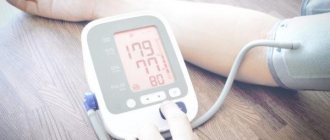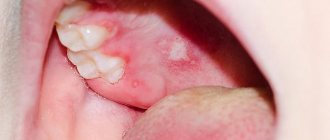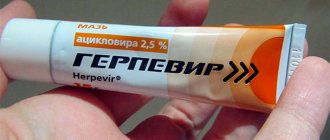How is herpes transmitted to children?
The herpes virus is very common and lives in almost all living things. It is transmitted by airborne droplets and contact . Once the herpes virus enters the body, it remains there for life. However, it can be in a “sleeping” state and not bother a person. If the herpes virus in a child has made itself felt, parents need to pay attention to this problem, because some herpes infections can take forms that are dangerous to health.
Children become infected with the herpes virus more often than adults, but overprotecting a child from infection is pointless and harmful. immunity to it . But the body is safe only in a situation where the infection is easy and without complications.
Epstein-Barr virus infection
An infectious disease caused by the Epstein-Barr virus (EBV) and characterized by a systemic lymphoproliferative process with a benign or malignant course.
EBV is isolated from the body of a patient or virus carrier with oropharyngeal secretions. Transmission of the infection occurs through airborne droplets through saliva, often when a mother kisses her child, which is why EBV infection is sometimes called the “kissing disease.” Children often become infected with EBV through toys contaminated with the saliva of a sick child or a virus carrier, when using shared utensils and linen. Blood transfusion and sexual transmission of the infection are possible. Cases of vertical transmission of EBV from mother to fetus have been described, suggesting that the virus may be the cause of intrauterine developmental anomalies. Contagiousness during EBV infection is moderate, which is probably due to the low concentration of the virus in saliva. The activation of infection is influenced by factors that reduce general and local immunity. The causative agent of EBV infection has a tropism for the lymphoid-reticular system. The virus penetrates the B-lymphoid tissues of the oropharynx and then spreads throughout the body's lymphatic system. Infection of circulating B lymphocytes occurs. The DNA virus penetrates into the nuclei of cells, while the proteins of the virus give infected B-lymphocytes the ability to continuously multiply, causing the so-called “immortality” of B-lymphocytes. This process is a characteristic feature of all forms of EBV infection.
EBV can cause: infectious mononucleosis, Burkitt's lymphoma, nasopharyngeal carcinoma, chronic active EBV infection, leiomyosarcoma, lymphoid interstitial pneumonia, hairy leukoplakia, non-Hodgkin's lymphoma, congenital EBV infection.
Types of disease in children
There are 80 types of herpes virus, of which 8 are dangerous to humans. The nature of the disease and the type of herpetic rash depend on the type of herpes simplex virus (HSV):
- Type 1 HSV - looks like cold-like rashes in the form of blisters on the lips, causes herpetic stomatitis and herpetic encephalitis.
- Type 2 HSV – manifests itself as a rash on the genitals (genital herpes).
- Type 3 HSV – causes chickenpox and recurrent herpes zoster.
- The 4th type of HSV - Epshane-Barr virus, causes malignant lymphoma and infectious mononucleosis - an acute viral disease with fever, damage to the respiratory tract, lymph nodes, liver, spleen and blood.
- Type 5 HSV – cytomegalovirus; affects the respiratory system, internal organs, intestines, eyes, brain, nervous and urinary systems.
- Type 6 HSV - causes viral eczema - exanthema - pseudorubella-type rash;
- The 7th and 8th types of HSV have not been sufficiently studied. Source: A.G. Lateral Herpesvirus infections in children - an urgent problem of modern clinical practice // Children's infections, 2010, No. 2, pp. 3-7
Enteroviral stomatitis
Enteroviral stomatitis (hand-foot-mouth syndrome) is also characterized by the formation of painful aphthae on the tongue, under the tongue, on the mucous membranes of the cheeks and lips, on the soft palate and at the base of the gums. Accompanied by a blistering rash around the mouth, on the palms, back of the hands, feet, back of the thighs and buttocks of the child, fever, sore throat, headache, loss of appetite.
The causative agents of enteroviral stomatitis are the Coxsackie virus and other enteroviruses. The disease is very common among young children in the summer and is transmitted through contact with an infected person through the airborne or fecal-oral route: through dishes, hygiene items, bedding, toys.
The incubation period (from infection to the onset of symptoms) is 3 to 6 days. Fever is often the first sign of illness. Painful aphthae in the mouth appear 1–2 days after the onset of fever, then rashes are observed on the arms, legs and buttocks. Enteroviral stomatitis does not require special treatment, all signs and symptoms of the disease usually disappear after a week, and the child’s condition returns to normal.
Virus activity
Most often, children are faced with the herpes simplex virus, which manifests itself in the form of that same cold on the lips.
Herpes on the lips or chickenpox are not as dangerous for a child as herpetic lesions of the eyes, genitals, and internal organs.
Externally, herpes appears as a rash on the skin or mucous membranes. It usually looks like small blisters that eventually burst and become sores. In addition to the rash, there is burning and itching.
How often the herpes virus is activated is influenced by hereditary predisposition and the state of the immune system. The weaker the child’s immunity, the more susceptible he is to virus attacks.
Newborns up to 1 year of age are protected by maternal antibodies. The peak incidence is observed at the age of 2-3 years. By the age of 15, up to 90% of adolescents are infected with HSV. The pathogen is in an inactive state in the body and does not cause discomfort. Under unfavorable conditions, HSV is activated. Source: A. Taieb, N. Diris, F. Boralevu, C. Labreze Herpes simplex in children. Clinical manifestations, diagnostic value of clinical signs, clinical course // Ann Dermatol Venerol, 2002, v.129, No. 4, p.603—608
Causes of exacerbations and relapses of herpes in children:
- decreased immunity due to severe and prolonged illnesses;
- severe shocks and chronic stress;
- systematic fatigue;
- hypothermia;
- taking hormonal medications;
- endocrine pathologies;
- hormonal changes in adolescence;
- systematic unbalanced diet;
- complicated seasonal colds;
- chemical and radiation anticancer therapy;
- excessive physical activity. Source: M.N. Kankasova, O.G. Mokhova, O.S. Pozdeeva Frequently ill children: the view of an infectious disease specialist // Practical Medicine, 2014, No. 9(85), pp. 67-71
Diagnostics
A patient suspected of having this disease is examined by a dentist. He asks the child’s parents about how the disease progressed. The diagnosis is established on the basis of the characteristic clinical picture of stomatitis, revealed during examination, anamnesis and characteristic complaints. Upon examination, typical mucosal lesions are revealed.
To confirm the diagnosis, laboratory testing of scrapings of the oral mucosa, the contents of ulcers, the patient’s saliva and blood is used.
The following are used for research:
- cytopolymerase chain reaction;
- immunofluorescence method;
- serological blood tests (RSC, ELISA, immunoglobulin M test);
- HSV test for the detection of immunodot G-specific glycoprotein.
These methods are used only for severe infections, as they are quite expensive.
Treatment of herpes in children
It is impossible to eliminate the herpes virus from the body, so the goal of treatment is to reduce its activity , eliminate symptoms by activating the immune system, achieve stable remission and prevent complications.
The most effective medicine against most manifestations of the herpes virus in children is the substance acyclovir. Treatment uses both oral and local medications. Source: I.F. Barinsky, L.M. Alimbarova, A.A. Lazarenko, F.R. Makhmudov, O.V. Sergeev Vaccines as a means of specific immunocorrection for herpetic infections // Questions of Virology, 2014, pp. 5-11
A comprehensive treatment regimen for acute herpetic infection includes:
- antiviral-antiherpetic drugs - tablets, injections and ointments - based on acyclovir;
- surface antiseptics for the prevention of secondary bacterial infections;
- immune stimulants – herbal and interferon derivatives;
- multivitamins and vitamins in therapeutic doses;
- antipruritic antihistamines;
- antipyretics;
- hepatoprotectors – in case of severe intoxication;
- diet therapy with sufficient amounts of protein and exclusion of foods that are sources of arginine.
In severe general condition, bed rest is recommended. Only a doctor can decide how to treat herpes in a child.
Which doctor treats a rash on the lips
A rash near the lips can be a dangerous symptom. If such manifestations occur, you should definitely visit a doctor, undergo prescribed tests and, if necessary, a course of treatment. First, you should visit a dermatologist, who will prescribe diagnostic procedures to identify the disease.
Even if the test for herpes is positive, many more parameters are taken into account when prescribing therapy: the number of antibodies, the stage of the disease, the individual characteristics of the body. This disease has 8 varieties, and appropriate treatment is selected for each.
If a reaction to certain substances and products develops, consultation with an allergist is required. There is often a need to visit an immunologist, since most diseases associated with a rash on the lips progress against a background of weakened immunity. But you should not visit the dentist if you have such symptoms. During dental treatment, the vesicles can become damaged and become infected, which causes inflammation and complications.
Possible complications
Without timely and adequate treatment, herpes infection can cause severe complications:
- disruption of internal organs;
- eye diseases;
- deafness;
- sore throat;
- nervous and mental disorders;
- infertility.
Sources:
- A.G. Side. Herpesvirus infections in children - an urgent problem of modern clinical practice // Children's infections, 2010, No. 2, pp. 3-7.
- Taieb, N. Diris, F. Boralevu, C. Labreze. Herpes simplex in children. Clinical manifestations, diagnostic value of clinical signs, clinical course // Ann Dermatol Venerol, 2002, v.129, No. 4, p.603-608.
- M.N. Kankasova, O.G. Mokhova, O.S. Pozdeeva. Frequently ill children: the view of an infectious disease specialist // Practical Medicine, 2014, No. 9(85), pp. 67-71.
- I.F. Barinsky, L.M. Alimbarova, A.A. Lazarenko, F.R. Makhmudov, O.V. Sergeev. Vaccines as a means of specific immunocorrection for herpes infections // Questions of Virology, 2014, pp. 5-11.
The information in this article is provided for reference purposes and does not replace advice from a qualified professional. Don't self-medicate! At the first signs of illness, you should consult a doctor.
Sources
- Lenart M., Działo E., Kluczewska A., Węglarczyk K., Szaflarska A., Rutkowska-Zapała M., Surmiak M., Sanak M., Pituch-Noworolska A., Siedlar M. miRNA Regulation of NK Cells Antiviral Response in Children With Severe and/or Recurrent Herpes Simplex Virus Infections. // Front Immunol - 2022 - Vol11 - NNULL - p.589866; PMID:33679688
- Gündoğdu M., Erden N., Karagun E., Acıpayam AŞF., Vural S. Annual pattern and clinical characteristics of herpes zoster in immunocompetent children in a rural area. // Dermatol Ther - 2022 - Vol34 - N1 - p.e14570; PMID:33219711
- Huang CW., Hsieh CH., Lin MR., Huang YC. Clinical features of gingivostomatitis due to primary infection of herpes simplex virus in children. // BMC Infect Dis - 2022 - Vol20 - N1 - p.782; PMID:33081701
- Cosme I., Ramírez MA., Peñata CA., Beltrán-Arroyave C., Florez ID. Human Herpes Virus 6 Detection in Children With Suspected Central Nervous System Infection. // Pediatr Infect Dis J - 2022 - Vol39 - N12 - p.e469-e471; PMID:32925539
- Weinmann S., Irving SA., Koppolu P., Naleway AL., Belongia EA., Hambidge SJ., Jackson ML., Klein NP., Lewin B., Liles E., Marin M., Smith N., Weintraub E. ., Chun C. Incidence of herpes zoster among varicella-vaccinated children, by number of vaccine doses and simultaneous administration of measles, mumps, and rubella vaccine. // Vaccine - 2022 - Vol38 - N37 - p.5880-5884; PMID:32444193
- Kanamori K., Shoji K., Kinoshita N., Ishiguro A., Miyairi I. Complications of herpes zoster in children. // Pediatr Int - 2022 - Vol61 - N12 - p.1216-1220; PMID:31628883
- Aktaş H., Erdal SA., Güvenç U. Herpes Zoster in children: Evaluation of the sixty cases. // Dermatol Ther - 2022 - Vol32 - N6 - p.e13087; PMID:31515892
- Hwang JH., Kim KH., Han SB., Kim HH., Kim JH., Lee SY., Choi UY., Kang JH. A clinical-epidemiological multicenter study of herpes zoster in immunocompetent and immunocompromised hospitalized children. // Clin Exp Vaccine Res - 2022 - Vol8 - N2 - p.116-123; PMID:31406693
- Agharbi FZ. . // Pan Afr Med J - 2022 - Vol32 - NNULL - p.199; PMID:31312311
- Pittet LF., Curtis N. Does oral antiviral suppressive therapy prevent recurrent herpes labialis in children? // Arch Dis Child - 2019 - Vol104 - N9 - p.916-919; PMID:31311776
Prices
| Name of service (price list incomplete) | Price |
| Appointment (examination, consultation) with a dermatovenerologist, primary, therapeutic and diagnostic, outpatient | 1750 rub. |
| Consultation (interpretation) with analyzes from third parties | 2250 rub. |
| Prescription of treatment regimen (for up to 1 month) | 1800 rub. |
| Prescription of treatment regimen (for a period of 1 month) | 2700 rub. |
| Consultation with a candidate of medical sciences | 2500 rub. |
| Dermatoscopy 1 element | 700 rub. |
| Setting up functional tests | 190 rub. |
| Excision/removal of cutaneous/subcutaneous elements and formations (1 element) | 2550 rub. |
| Removal of milia of one unit using electrocoagulation | 350 rub. |
Prevention
Preventive measures are aimed at preventing infection. This presents certain difficulties, since the vast majority of the population is infected with it. It is better if the child gets sick from it at an older age.
For this it is recommended:
- avoid contact with infected people;
- will provide personal utensils and personal hygiene products for the child;
- Kissing people with herpetic rashes is prohibited;
- strengthening the baby's immune system.
It is recommended that the child be provided with adequate nutrition and regularly given vitamin and mineral complexes.










